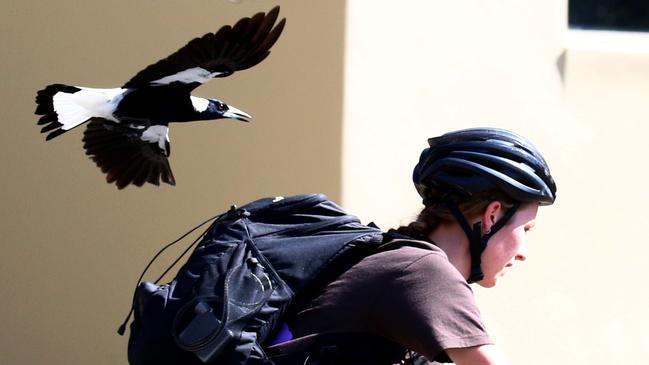When do magpies swoop: Magpie swooping hotspots revealed
Magpie swooping season is in full flight, with terrifying attacks reported at popular playgrounds, bike tracks and parks.
Inner East
Don't miss out on the headlines from Inner East. Followed categories will be added to My News.
Magpie swooping season is in full swing, with cyclists and walkers across the state ducking for cover.
And even playgrounds are not safe, with several reports of the birds swooping at parks in Chelsea, Elwood and St Kilda East.
Spring is the most common time for swooping, as male birds defend chicks in nests.
Dozens of attacks have been reported across the state on the Magpie Alert website, in locations including Chelsea, St Kilda, Elwood, Mount Beauty, Kew, Warragul, Pascoe Vale and Torquay.
One woman reported she had been swooped three times while walking along Plumpton Rd Glenroy, suffering a superficial injury to her head.
The state government’s Swooping Bird map also reveals the magpies are out in force swooping cyclists along the popular Warburton Rail Trail in the Yarra Ranges.
A cyclist also reported being knocked off their bike by a swooping bird on Callista Circuit, Taylors Hill.
Kingston Council recently received multiple reports of swooping at Chelsea’s Bicentennial Park, with a young boy injured.
“The safety of our community is our top priority, and the slide area at the park will be temporarily closed. The rest of the park and playground will stay open. We’ll monitor the situation closely, and reopen the slides as soon as it’s safe,” the council posted online on September 15.
The City of Port Phillip said magpie nesting season had appeared to start early, with reports of swooping on Point Ormond Playground, Elwood and Alma Park Playground, St Kilda East late last month, while Hume City Council has installed warning signs in busy areas to warn locals magpie swooping season is in flight.
Social media has also lit up as magpie swooping season hits, with TikTok user bartsimpsonfan69 describing them as the “eshay” of the bird world thanks to their black and white “tracksuits”, in a clip viewed more than 22,000 times.

BirdLife Australia National Public Affairs Manager Sean Dooley said while magpies seemed to be everywhere, only a fraction of the birds swooped.
“The only time a magpie swoops is when it’s a male magpie defending chicks in the nest,” he said.
“We started to get reports of swooping from early August, but certainly now, late September, is really the peak time.
“That’s when the majority of magpies, their chicks have hatched, they’re coming back and feeding them, and the chicks are at their most vulnerable and that seems to ramp up the male’s protective instincts.”
Mr Dooley said only about 10 per cent of magpies decide that certain people are a threat.
“They only swoop individuals they dislike for whatever reason.
“If you think it’s personal it is.
“You might not have done anything that you’re aware of, it might be you have just stood for too long under the nesting tree, and they thought you’re trying to work out a way to get to the eggs or something.”
Mr Dooley said magpies tended to swoop cyclists more often than pedestrians, and were often “freaked out” by the speed of bikes.
He said magpies were “really smart” and could remember well over 30 individual human faces.
But he said in high traffic areas like parks or schools, magpies can’t recognise all individuals, and start to mark out types of people to swoop.
“If you happen to look like one of those types, it can be frightening if they swoop you.”
Mr Dooley said it was important not to panic if get swooped by a magpie.
“A lot of more serious injuries occur when people panic and think the magpie is a psycho and crash their bike or get injured falling over,” he said.
“The worst thing you can do is panic and go crazy and run around screaming, throwing things at the magpie or just running around waving your arms in the air because the magpie will perceive that to be a continuation of the threat.”
He said the best thing to do was turn and face the magpie, and without running, move out of its territory, heading back the way you came.
He advised cyclists who were regularly being swooped on their daily routes to get off their bikes about 100m from the spot, and walk slowly through the magpies’ territory.
Mr Dooley said despite a lot of fear during swooping season, magpies were a beautiful native bird.
“We should be grateful we’ve got such a beautiful songster that still survives in our urban and suburban areas,” he said.
“And we should be celebrating the fact we can share our spaces with these native birds, and be more aware that it’s their home too.”


